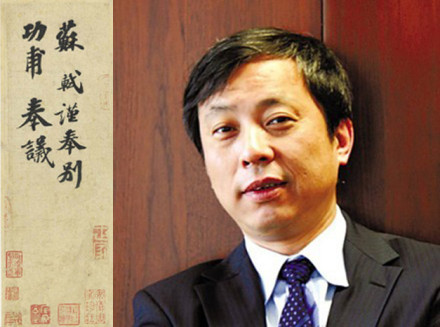Auctioned calligraphy dismissed as fake
 0 Comment(s)
0 Comment(s) Print
Print E-mail Shanghai Daily, December 22, 2013
E-mail Shanghai Daily, December 22, 2013
 |
|
The buyer, Liu Yiqian, a Shanghai-based private art collector, aficionado and investor, had planned to display the work at his Long Art Museum next year. |
Three researchers from Shanghai Museum are insisting that a calligraphy supposedly belonging to famous poet and politician Su Shi (1032-1101), and attracted interest at a Sotheby's auction in New York in September, is fake.
The successful buyer has announced plans to exhibit it at a private museum next year.
The Gong Fu Tie Calligraphy, a hanging scroll with just nine characters, was sold for US$8.229 million at Sotheby's in the Fine Classical Chinese Paintings and Calligraphy auction on September 19 after 70 rounds of heated bidding. It has been described as one of the finest examples of calligraphy ever produced.
Su is a figure comparable with the great Renaissance masters in Chinese culture, and manuscripts attributed to him are among the nation's most sought after treasures.
The buyer, Liu Yiqian, a Shanghai-based private art collector, aficionado and investor, had planned to display the work at his Long Art Museum next year.
The Gong Fu Tie was a farewell letter to Su's close friend Guo Xiangzheng (1035-1113). Guo, also known by his literary name Gong Fu, was a poet as well. They differed in political views, but were good friends and exchanged poets and paintings often, according to historical records.
The calligraphy, completed when Su was about 36 or 37 years old, was hailed by experts as "a divine piece of calligraphy."
However, three researchers with Shanghai Museum, Zhong Yinlan, Shan Guolin and Ling Lizhong, said the Gong Fu Tie bought by Liu was a forgery, the Xinmin Evening News reported yesterday.
The three researchers compared the piece bought by Liu to a stone carving of the Gong Fu Tie by a Huizhou merchant Bao Shufang (about 1763-1807). Bao reportedly carved the calligraphy on a stone.
The researchers said the work bought by Liu did not even match the fake work on the stone in terms of technical sophistication, and was in fact coarse.
The technique the forger used on the stone originated in the Tang and Song dynasties and was aimed at protecting the original works. It was used in late Qing Dynasty (1644-1911) mainly for forging, the three researchers said.
They said they suspected the work even before it reached the auction house.
Liu told Sina.com yesterday that he had contacted Sotheby's over the issue. The auction house has said it will invite experts to investigate the authenticity of the piece. Liu said that before bidding at the auction, he had consulted calligraphy experts who had vouched that it was genuine.






Go to Forum >>0 Comment(s)